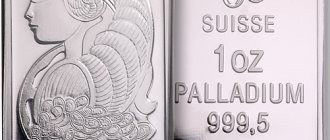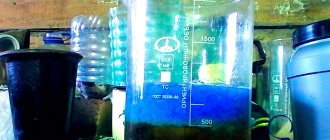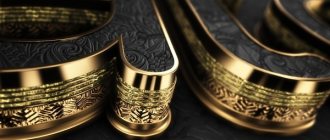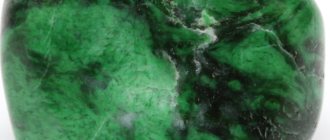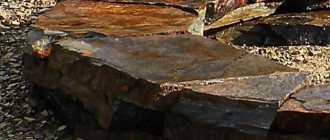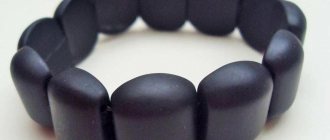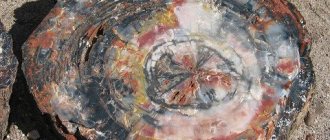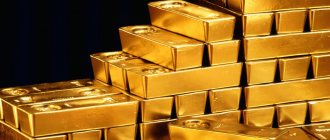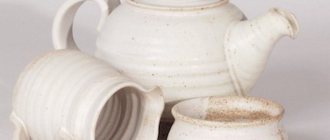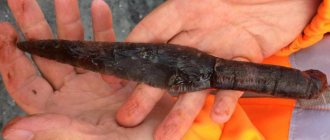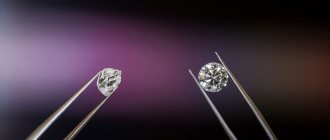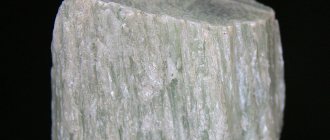Palladium is one of the varieties of precious metals that has become quite widespread in various industries. For example, palladium is used to create a variety of jewelry. This metal is also characterized by unique physical and chemical properties, relatively low cost and similarity to platinum, which also has a positive effect on its popularity. This material will discuss its practical use in more detail, as well as all its features.
Application
The precious metal has found application in jewelry; its density is close to silver - 10.49 g/cm³, melts at a temperature of 1552 °C, boils at 3980 °C. Heated raw materials are welded, easily forged, and can be processed at a temperature of 22-25 °C. The mechanical characteristics of pure Pd are not constant; they are improved by additives .
Jewelry with a high level of mechanical resistance is made from 850-grade palladium. The cost of men's (women's) chains is 7-70 thousand rubles. Cufflinks and rings with onyx, diamond, and agate are in constant demand among men. For women, the trend is hairpins, earrings, brooches, rings with or without inserts.
On a special date, the event is given:
- pendants;
- bracelets.
Jewelers make expensive exclusive models to order ; wedding rings from the latest collections of leading jewelry houses in Europe and America are valued at several thousand dollars.
13% Pd is present in 583 white gold
Gold
Today, gold is considered not only the most precious, but also the “oldest” metal. The first reliable evidence of the use of gold was found in Ancient Egypt and dates back to 3000 BC. Gold has always played a central role in the culture and mythology of various civilizations. For example, in Ancient Egypt it was revered as the metal of the gods, the ancient Greeks considered gold a metal of social status and wealth, and the kingdom of Lydia first began to use it as a currency.
Already in ancient times, people realized that properties such as corrosion resistance, malleability, ductility and luster make gold ideal for creating jewelry. However, people who belonged only to the highest ranks could own it. Today, gold is valued as highly as it was many, many centuries ago, but with the difference that in modern society it has become available to everyone thanks to various samples, or rather due to the alloys used, which significantly reduces its cost.
https://youtu.be/AhiaqjVPlNw
Where is refined metal accepted?
Pure palladium is accepted at a price of up to 2,700 rubles per gram.
However, it should be remembered that illegal trafficking in precious metals is prohibited by law . And if you are refining palladium at home, you are unlikely to have a package of permits.
For law-abiding citizens, there is only one way out of the situation - to hand over radio components containing this element to specialized purchasing points that have a license for circulation .
In companies buying metal, there is the following division:
- knitting needles, needles, palladium contacts and more (alloy content 18-28%) - cost per gram 230-360 rubles
- in products with a content of 80%, for example, winding from strings - 1000 rubles .
Prices are average.
Mining and industrial production
The production of pure metal is carried out in several stages:
- Preparation of consumables. It is heated in special porcelain cauldrons. During the heating process, the boilers are filled with aqua regia.
- Transferring platinum into sediment using special filters. Additives and third-party components that are interesting for the production of palladium are separated from the base.
- Filtrate treatment. A refining procedure is carried out, during which a sparingly soluble compound is obtained, which is called palladium dichlorodiammine.
- Purification of the desired metal from impurities.
- Calcination. It is carried out in sealed chambers filled with hydrogen.
The resulting sponge palladium is melted into blanks of the required size and shape.
Enrichment
It involves processing the resulting ore to obtain a high-quality, impurity-free concentrate that contains valuable metals. A ton of ore obtained contains only up to 6 grams of precious metals. To increase the concentration of palladium, the artificial principle of enriching ore with platinum minerals is used.
The ore is first crushed to a powder using special equipment. Water and special reagents (usually nitric acid) are added to the resulting product. Next, a high-pressure air stream is used.
Thanks to ionization, mineral molecules begin to be attracted to air bubbles. As a result, the bubbles float to the surface along with the precious particles, forming a foam-like mass, which is collected in a special container and then dried.
Once the mixture dries, a concentrate with a high platinum content appears. One ton contains up to 1 kg of metal without impurities. Further processing is carried out in an electric oven at a temperature of 1500 degrees. A slag mass is released from the by-products and must be removed.
The mass resulting from firing is sent to a converter furnace. It eliminates sulfur and iron. In 1 ton of ore, the output is up to 1.4 kg of pure metal without unnecessary impurities.
Affination
After processing in the converter furnace, the concentrates are sent to specialized refining plants. Modern equipment and the latest technologies help to isolate pure palladium from the resulting mass.
Affination is a production process that results in the separation of a pure substance from the total mass. An ingot or powdery mass is formed from the clean resulting mass to be sent for transportation to a storage location.
Excluding transportation time, the total production process averages 6 weeks.
History of appearance
Palladium is a ductile mineral with a silvery-white color. Due to its properties, palladium looks like platinum. However, it is immediately worth noting that it belongs to the category of platinum minerals, so this similarity is easy to explain.
This mineral was discovered in the 19th century by British chemist William Wollaston. He conducted chemical experiments with platinum ore, during which he was able to isolate palladium. Its name is explained by the name of the asteroid Pallas, which was discovered a year earlier. In turn, the asteroid received a similar name in honor of the ancient Greek goddess Pallas Athena.
Home methods for determining the authenticity of palladium
At home, you can determine what metal is in front of you, even without deep knowledge of physics and chemistry or expensive equipment in the bushes.
So, if you bought an unmarked ring at a flea market, and the seller insisted that it was white gold, there are several ways to determine whether the jewelry actually contains palladium, or whether it is a nickel alloy. So, how to check what kind of metal is in front of us?
By weight and density
The method is simple and fast. But you will need fairly accurate scales - with an error of up to one hundredth of a gram. And distilled water, it is easy to get at any pharmacy or auto store.
What I did to determine what my ring was made of:
- I weigh the dry decoration – 3.12 g.
- I pour distilled water into a glass, place it on the scale platform and weigh it. The mass of a glass of water is 172.21 g. If the scales have a zeroing function, you can skip this step by simply resetting the scales to zero.
- I hang the ring on a thread and completely immerse it in a glass of water so that the product does not touch the bottom or walls.
- I record the weighted result - 172.48 g.
- The difference between the masses is equal to the volume of the ring. 172.48-172.21=0.27 cm3.
- I calculate the density of the product: 3.120/0.27 = 11.56 g/cm3.
- I look at the table of metal densities on the Internet. There are several suitable ones in the range from 8 to 12:
- silver – 10.49;
- palladium – 12.02;
- nickel – 8.96.
Considering that palladium jewelry alloy usually contains silver and nickel, I conclude that my ring is palladium, and of a fairly high standard. One cannot help but rejoice having determined such a value.
Using nitric acid
Palladium is the only precious metal of the platinum group that dissolves in nitric acid, so by the reaction to a small drop of the reagent we can determine which alloy is in front of us.
If the surface of the metal being tested turns a reddish tint, we can say with confidence that this is palladium. I would like to note that when working with acids you should be extremely careful and use protective equipment.
Using a touchstone
A touchstone is a black slate or jasper plate with a set of needles made of precious metals for testing. From the set, select the needle most suitable in color for the metal being tested and draw a line on the touchstone. Then we clean a small area of our product and draw the same strip on the touchstone.
Physical and chemical properties
The color of palladium is silvery-white, like silver, so it is difficult for a non-specialist to distinguish between these precious metals; Pd is often confused with platinum. Palladium is not used in its pure form, since it is a fragile, fragile material . To obtain raw materials of the required quality, a ligature is added to the composition of the palladium jewelry alloy.
The permissible amount of unspecified components is 0.11% by weight of the alloy
Pd samples on jewelry:
- 500 − 50% Pd, 38% silver, 0.1-0.2% silicon and copper.
- 850 – 85% Pd, 2-2.5% gold, 0.01-0.5% rhodium and silver.
Silicon is added to the alloy to give the required hardness of 160 Vickers, copper and silver are added to improve jewelry qualities.
Impurities change the initial properties of natural palladium, the hardness and tensile strength increase by 2 times.
A Fundamental View of Platinum and Palladium
How were supplies from mines affected by coronavirus at the start of 2020 and do you expect a recovery?
With global platinum production concentrated in South Africa, the metal has been severely impacted by the COVID-19 situation. Mining operations have been forced to temporarily shut down operations since late March, and although production resumed in mid-April, many were not allowed to operate at full capacity until early June. These closures come amid existing disruptions in the industry. Back in March, Amplats announced the closure of the entire Anglo Converter Plant (ACP) complex, effectively stopping metal production for 80 days. These reserves were planned to support refining volumes until 2022. However, due to a reduction in production, the planned increase in volumes did not occur. The impact of COVID-19 will accordingly extend into 2021. Palladium supply has also suffered significantly, although due to its greater geographic diversification, to a lesser extent than platinum.
What are your platinum and palladium forecasts for 2020/2021?
Despite the pandemic, the fundamental outlook for platinum and palladium will generally display similar characteristics to those seen over the past five years. Given softer fundamentals for platinum compared to palladium, another surplus in the physical metal is expected in 2020 and 2021; palladium, given strong fundamental conditions, will show deficit over the same period. However, the pandemic will continue to have a significant impact on these markets in 2021. Even in 2021, despite expectations of a strong recovery, neither demand nor supply will return to 2021 levels.
Can you talk about the fundamentals of demand for platinum and palladium and the role of the automotive sector, including geographic division, vehicle type, etc.?
The automotive sector is the main demand segment for both platinum and palladium, accounting for 35% and 82% respectively of total demand in 2021. These metals are particularly effective in the catalytic process of converting toxic gases and pollutants into less harmful emissions, with platinum performing better in diesel engines and palladium being better suited for gasoline engines. In 2021 and 2021, the dominant powertrain will remain gasoline or diesel internal combustion engines (ICEs), which require either platinum, palladium, or both.
With the regional phase-out of ICE powertrains, demand for low-emission vehicles has been higher in Europe, driven by lingering memories of the diesel scandal and, more recently, targeted incentives introduced by governments to support the automotive sector in response to the devastating impact pandemic.
In the world's largest auto market, China has for several years introduced a series of regional and national incentives to increase production and adoption of clean energy vehicles. However, with China still favoring gasoline-powered vehicles, demand for palladium in the automotive sector continues to grow significantly. Automotive demand for palladium in China is expected to rise next year due to projected growth in car production and strict emissions legislation.
The North American auto market is half the size of China's, but demand for palladium in the region is the second-largest in the world due to consumer preference for large gasoline-powered cars. The share of electric vehicles in the region is growing steadily, but remains modest in absolute terms.
What have been the main trends in platinum and palladium investing in 2021?
Platinum has experienced noticeable price fluctuations over the past year. After falling to $591 on March 19, it broke through the psychologically important $1,000 level in early August. However, the metal has since lost much of its momentum and returned to around $860.
Price volatility this year has been closely linked to the pandemic, but platinum investment is largely driven by the path of the gold price. Amid ongoing uncertainty, investors have turned to safety assets. ETF holdings hit a record high in September, but investors are being cautious on the futures exchange, with shorts rising ahead of longs.
In contrast, the illiquid palladium market and its extreme volatility limit the volume of new investment by institutional investors.
How do platinum and palladium scrap recycling and supply markets affect supply and prices?
The secondary market plays a critical role in the supply of both platinum and palladium. The most important is the collection of PGMs from spent autocatalysts. Higher prices do have some impact, and depending on the extent of price increases, there is some potential for landfills to speed up deliveries. The price of steel can also influence the quantity and speed at which spent catalyst reaches the market.
Posted by Wilma Swarts November 30, 2021 | Translation: Gold Reserve
Silver
The history of silver is as long as the history of gold. Since ancient times, silver has been used to mint coins. It is curious that at some point in their history, Ancient Egypt and Ancient Greece valued silver more than gold, and silver jewelry and cutlery were truly luxury items. For a long time, silver was the basis of the monetary system of Great Britain and the United States of America.
Silver is a noble, ductile and malleable metal that has a relatively low melting point (962 degrees), which makes it especially popular among jewelers. Silver, like gold, is not subject to corrosion and retains its impeccable appearance for centuries. Thanks to the skillful work of jewelers and the inclusion of precious stones, silver items not only do not decrease their value over time, but often increase it.
Where can I find the item?
This platinum group element can be found in complex radio engineering and electrical engineering in the form of sputtering of special conductors and contacts. This spraying is done in order to prevent oxidation and protect against sulfides.
In addition, the element can be found in:
- printed computer boards (mostly from Soviet times);
- various resistors (their metal core is often coated with palladium);
- individual parts of recorders;
- some potentiometers (they have a palladium shell);
- radio components SHIV-25;
- ceramic capacitors of the KM-3, 4, 5 and 6 series (often produced in the 80s);
- generators of the GC-164, GC-151, GC-122, GC-165 series;
- meters of the P2-73, E7-14, E7-15 series;
- resistors of the PPBP, PPZ-43, P-74 series.
Detecting pure palladium is quite difficult. It is used exclusively in jewelry, and very rarely. Most often, this precious metal is found in the form of an alloy with other metals, including in individual elements of radio engineering.
Determine the weight and density of the decoration
Platinum is quite heavy and can only be compared with the metals of its group: iridium, osmium, uranium and rhenium. All other metals are much lighter. On top of that, when producing jewelry, the weight of platinum will be from 85% to 95% of the total mass. In other words, platinum jewelry is made almost entirely of base metal. And therefore, how to distinguish platinum from possibly similar other metals is a very important question.
For example, gold and silver products have less precious metal in their mass, which affects its cost and overall value. In such a mixture, it is not advisable to use iridium, osmium or rhenium for weighting, since they, in addition to the same price as platinum, are also rarely found in the natural environment. To understand whether the jewelry is made from real raw materials, you need to select a sample that needs checking and compare it with one of similar size. Such a ring will be much heavier than the opponent, but if the ring is the size of a grape, you will have to use precise scales to determine the platinum.
If you have a measuring cup or other vessel for measuring volume, you can use it to measure the density of the decoration. To do this, weigh the product and lower it into a vessel with water, after which we look at the volume of water squeezed out in cubic centimeters (should be about 21.45).
If approximately 21.45 cubic centimeters of water have been removed, then we can talk about the authenticity of the decoration.
How to distinguish palladium alloy from silver
Buyers in jewelry stores ask consultants a reasonable question: why is palladium alloy better than silver? They look similar in appearance, but the price is different:
- silver wedding ring without inserts – 500 rubles;
- classic engagement ring 4 mm wide made of palladium (without inserts) – 20-25 thousand rubles.
The price of palladium jewelry is tens of times higher, so you can buy a fake. High cost guarantees quality. Rings, earrings, bracelets, and chains made of palladium are resistant to corrosion , which distinguishes them from silver jewelry. There are other advantages:
- lungs;
- do not fade or darken over time;
- do not cause allergies;
- do not wear out;
- metal emphasizes the noble beauty of precious stones: diamonds, emeralds.
It is profitable to purchase wedding rings of 950 standard, they are easy to roll out if your finger gets fat
There are several ways to determine the authenticity of a palladium ring, but first you should study the hallmark, since each precious metal has its own. A counterfeit is determined by potassium iodide and aqua regia - a solution of nitric and hydrochloric acid (3:1), Pd dissolves , and a protective film is formed on the silver surface.
You can check the composition of a jewelry alloy with concentrated nitric acid (NHO₃):
- on Pd the liquid becomes brown;
- A gray trace of a drop appears on Ag.
A good indicator is heating; under the influence of high temperatures, palladium jewelry does not darken , but becomes shiny like a mirror.
